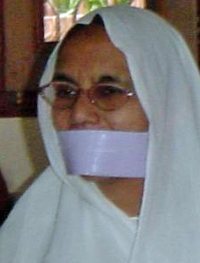
Pranayam
The technique related to breathing pattern in which balanced, regular, and rhythmic inhalation and exaltation in specif! method is performed is known as pranayam. It comprises four stages:
- Purak (inhalation)
- Rechak (exhalation)
- Antrika kumbhak (holding the breath inside after inhalation)
- Bahya kumbhak (holding the breath outside after exhalation)
The concept of prana can be illustrated through an example. Electricity flows through a wire to a bulb. The presence of electrici can only be felt when the bulb lights up. Similarly, prana is the vit energy that like electricity flows through the human body and gets manifested through our actions. Pranayam is the technique to master over this prana.
Types
There are several types of pranayam, which mainly differ in the way exhalation and inhalations are performed. A comprehensive list o some of the most important types of pranayam is given below. A detailed description of various type of pranayam can be found in Preksha Meditation: Yogasana and Pranayam.
- Surya-bhedi pranayam
- Chandra-bhedi pranayam
- Anuloma-viloma pranayam
- Bhastrika pranayam
- Kappalbhati pranayam
- Sheetali prasiayam
- Ujjai pranayam
Objectives
Pranayam serves the following objectives:
- Development, expansion, and control of vital energy
- Regulation of the flow of vital energy throughout the body
- Creation of a link between the physical body and the soul
- Healing of physical and mental disorders
- Harmony between the sympathetic and parasympathetic nervous systems
Benefits
The various stages of a well-performed pranayam provides the following benefits:
In general, pranayam promotes uninterrupted flow of the vital
energy through nerves
- Inhalation gives energy to the body Exhalation cures the abdominal ailments
- Holding the breath awakens the inherent potentials
- Some pranayam such as chandra-bhedi cools the body, purifies the blood and reenergizes the body. Similarly, sheetali pranayam quenches the thirst, regulates the blood pressure, and enhances the glow of the face. It also reflects the coolness and tranquility of mind.
- Pranayam controls the breath rate and help to improve mental concentration
- Pranayam helps in realization of divine and intuitive powers
Specific recommendations
It is essential to learn the correct technique of pranayam before we practice it. An ill-performed pranayam may effect the health! adversely. Following are some of the precautions that must be considered in order for pranayam to be effective:
- Select a neat, clean, and noise-free location
- Always perform pranayam with empty-stomach
- Keep the neck and the spine erect and straight
- Keep the body relaxed
- Never perform pranayam if intoxicated
Conclusion
Pranayam is a scientific technique of correct breathing process. Well-performed pranayam not only assist in sustaining good physical health but also heal diseases that are otherwise difficult to tackle.
 Sadhvi Vishrut Vibha
Sadhvi Vishrut Vibha

